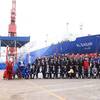IOCs Stress on OSV Fuel Management Performance
Growing insistence by international oil companies (IOCs) that oilfield contract vessels (OSVs) are fitted with fuel monitoring systems has prompted an upsurge in interest in marine engine monitoring systems.
Diesel power specialist Royston reports that it is equipping a growing number of offshore vessels with its enginei fuel management system as the oil majors increasingly require the availability of accurate on-board fuel monitoring data as part of the support contracts awarded to shipping companies.
Around the world, enginei is now installed on nine vessels working for Chevron, two for BP, one for Addax Petroleum, four for Total, two for Conoco Phillips and one for Exxon.
In Nigeria alone, over the last two years, Royston has fitted over 30 vessels with the enginei system for the monitoring of bunkering and fuel consumption data.
However, the trend is not confined to West Africa, with enginei-equipped vessels also operating in Asia, Egypt, Mexico and Brazil. In the North Sea, Royston also recently installed a fuel monitoring system in a vessel operated by Gulfmark for a Shell contract.
Despite the low oil price, it appears that access to accurate and reliable fuel consumption data is taking on even greater importance for a wide range of fleet management issues.
Damian McCann, product manager for enginei fuel management systems at Royston, explains: “Over the last two years a number of factors have come together as part of a definite trend that has seen the IOCs requiring fuel monitoring data provision in offshore support contracts.
“These factors include better visibility of operational costs and contract cost reductions, encouraging improved vessel handling and working efficiencies, and closer attention to emissions control, as well as fuel security issues.
“Although the trend started with high fuel prices around two years ago, there is no doubt that it is here to stay and even in the current low oil price scenario we are still undertaking new installations.
“In the North Sea, for example, both Gulfmark and Shell have said they are extremely happy with the range of data they are seeing from the on-board and remote monitoring. We are also aware of clients who are intending to highlight the inclusion of enginei in future contract tenders, such are the fuel management advantages it provides.”
The enginei system records the fuel consumption data which is presented on board via touchscreen monitors installed on the bridge and in engine control rooms.
In addition, the technology remotely sends the information from ship to shore where it can be accessed through a simple web dashboard with computer generated graphs and Google mapping to show an operational profile of a vessel. Shore staff can then access live and historical data in order to analyse the performance of their vessels.
In addition, specific fuel burn data can be provided for different vessel operational modes, as well as consumption measurements per passage and by different captains. This increased scope means the on-board monitoring system can be configured to meet precise operator requirements.
The system permits daily ‘noon day’ logs from the vessel to be imported into the enginei server so that the charterer or vessel owner can see all the vessels fuel data/activity from one online enginei dashboard and without the need to install flow meters/hardware.
With the growth in interest, enginei is now installed on OSV’s of all types, including anchor handlers, jack ups, PSVs and crew boats. The typical system requirements are the measurement of individual engines and fuel bunker activity.
Damian McCann continued: “The monitoring need is essentially being driven by the IOCs trying to reduce the burn of fuel that they pay for.
“However, it is interesting to hear that PEMEX has apparently changed this strategy and will no longer pay for the fuel in all future oilfield service contracts. If so, this means that the vessel operator will then have to manage fuel a lot more closely than is currently the case.
“From a fuel monitoring perspective, this would be a big sea change in the OSV market and whether other majors follow is yet to be seen, but whatever the situation, any future recovery in the oil price would lead to even greater importance being put on effective fuel management.”
At the moment, the requirement for fuel monitoring systems to be installed is only being applied to longer term contracts of over one year. In most cases vessel operators are paying for the systems to be installed and the monitoring instrumentation will stay in place after contracts have ended. However, at the end of contracts, there are already examples of operators removing them for re-fitting onto others vessel depending on contract arrangements.
The enginei integrated fuel management system is compatible with all marine engine types and can be interfaced with new-build engine installations or retrofitted to operating vessels.














